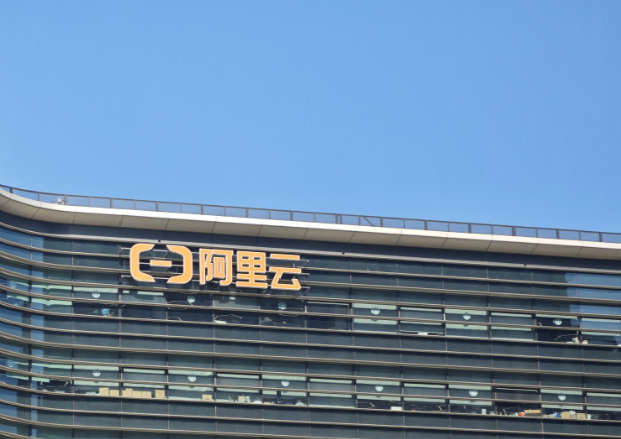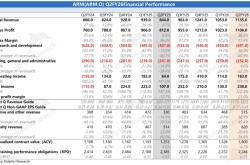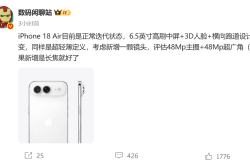Cloud and AI: The Catalyst for Alibaba's Growth
![]() 09/05 2025
09/05 2025
![]() 610
610
Written by | Hao Xin
Edited by | Wu Xianzhi
Alibaba's financial report for the first quarter of fiscal year 2026 has been released, albeit with a slight delay.
Initial concerns that heavy subsidies for instant retail would erode profits were quickly overshadowed by the impressive growth in cloud computing and AI sectors.
For the quarter ending on June 30, 2025, the Cloud Intelligence Group reported a revenue of 33.4 billion yuan, marking a 26% year-on-year increase and achieving the highest growth rate in the past three years. Excluding revenue from consolidated subsidiaries, the revenue growth rate also stood at 26%, primarily fueled by growth in public cloud revenue. Notably, revenue from AI-related products maintained triple-digit year-on-year growth for the eighth consecutive quarter.
Chief Financial Officer Xu Hong highlighted that the robust demand for AI has spurred demand for other public cloud services, including computing and storage. The department's adjusted EBITA also saw a 26% year-on-year increase, reaching 2.95 billion yuan.
The stellar performance of cloud computing served as a market catalyst, driving Alibaba Group's stock up by 13% at one point.
In this quarter's financial report, Alibaba's '1+6+N' organizational structure has been reconfigured, with the six major groups being streamlined into four businesses, fully focusing on e-commerce and 'Cloud + AI' strategies. In a short span, these two main businesses formed a hedge, with financial fluctuations from Taobao Flash Sales being mitigated by the growth potential unlocked by cloud and AI. The growth signal from the cloud business, acting like an anchor, has to some extent alleviated anxieties for Q3 (the intense phase of the food delivery war).
Despite having ample reserves, the initial signs of a dual-front battle have already exerted immense pressure.
The financial report reveals that Alibaba Group experienced a net outflow of 18.815 billion yuan in free cash flow for this quarter, compared to a net inflow of 17.4 billion yuan in the same period last year, resulting in a substantial gap of 36.2 billion yuan. This was primarily due to increased spending on cloud infrastructure and large-scale investments in 'Taobao Flash Sales'.
Whether viewed in the short or long term, the burden on Alibaba Cloud appears to be intensifying.
MVP Player
How did Alibaba Cloud, the standout performer in this quarter's financial results, fare?
Compared to its historical benchmarks, Alibaba Cloud's quarterly revenue growth rate reached a record high.
The first quarter of fiscal year 2025 (April-June 2024 in the calendar year) marked a turning point for Alibaba Cloud's trajectory. Prior to this, its revenue growth had plateaued. However, in the first quarter of fiscal year 2025, investments in large models and AI began to yield results, with Alibaba Cloud's revenue increasing by 6% year-on-year. Subsequently, it broke free from the stalemate, achieving sustained year-on-year growth rates of 7%, 13%, 18%, and culminating in 26% in the first quarter of fiscal year 2026.
The revenue growth trajectory of Alibaba Cloud indirectly underscores the pulling effect of the AI cloud market. The financial report indicates that driven by eight consecutive quarters of triple-digit growth in AI-related revenue, AI revenue now accounts for over 20% of external commercialization revenue this quarter.

When compared horizontally, as a seasoned cloud provider that has weathered various market cycles, Alibaba Cloud's revenue growth rate is quite impressive. In the quarter ending June, AWS's revenue increased by 17.5% year-on-year; Google's revenue grew by 13.9% year-on-year in the second quarter; and Microsoft's overall cloud sales increased by 27% year-on-year.
Analyzing Alibaba Cloud's revenue growth in the first half of the year, it primarily stemmed from two sources: the explosive growth driven by DeepSeek during the Spring Festival and the new post-training demands triggered by the Agent application paradigm.
As the first full quarter to benefit from DeepSeek domestically, the growth rate in the second quarter of 2025 better reflects normal business trends. Wu Yongming revealed in last quarter's earnings call that large-scale launches of client projects driven by the DeepSeek effect were concentrated in Q2. This encompassed both traditional computing demand and a portion of inference demand.
Another significant increase came from a shift in how clients train models. Enterprises are no longer relying on data flooding to train models but are optimizing them for specific enterprise scenarios. They first annotate scenario-specific data and then perform Supervised Fine-Tuning (SFT) on open-source or closed-source models. Post-pretraining, similar to pretraining, consumes a substantial amount of tokens and computing power and requires in-depth industry know-how, presenting a new commercialization opportunity for cloud providers.
Wu Yongming mentioned that they have also identified new opportunities in training directions, with some education and healthcare companies conducting post-training based on the open-source Tongyi model. Alibaba Cloud views this as a new commercialization avenue for open-source models and plans to offer post-training-related services in the future.
'Given the rapid growth in inference demand, we anticipate Alibaba Cloud's overall growth rate to continue its upward trajectory in the coming quarters.'
In terms of profitability, Alibaba Cloud's adjusted EBITA margin slightly increased to 8.8% quarter-on-quarter in the new quarter. Capital expenditures surged from approximately 11.9 billion yuan in the same period last year to approximately 38.7 billion yuan this quarter. Due to these heavy investments, the profit margin has not yet returned to its peak.
From Profitability to Market Capture
Wu Yongming believes that compared to traditional cloud computing, the changes brought about by AI will significantly enhance market concentration in the cloud computing market. The advent of AI technology necessitates developers to utilize more technology stacks when developing applications, prompting them to opt for providers with a comprehensive technology product portfolio, 'especially those with leading capabilities in individual products.'
Currently, Alibaba Cloud directly competes with Google Cloud in infrastructure, model research, products, and platforms.

The latest news states that Alibaba is independently developing a new generation of AI chips, to be manufactured by domestic foundries, compatible with NVIDIA's software ecosystem, and primarily targeted at AI inference tasks.
Strategically, Alibaba Cloud has finally addressed a critical gap in 'autonomous and controllable computing power.' Self-developed AI inference chips can reduce reliance on external suppliers like NVIDIA, enhance supply chain resilience, and ensure a steady computing power supply. On the other hand, they can also improve pricing power and cost control capabilities, enabling Alibaba Cloud to continue reducing inference costs and increasing gross margins under its existing scale advantages.
Leading foreign cloud providers such as Amazon, Google, and Microsoft are all pursuing the 'Cloud + Self-Developed Chips' strategy, providing valuable references for Alibaba Cloud's decision-making. After strengthening the vertical integration of 'Cloud + AI + Chips,' Alibaba Cloud will form a trinity capability of 'Cloud Platform + Large Models + Chip Infrastructure,' which is conducive to building higher market barriers in the future.
At the model layer, Alibaba's Tongyi large model family competes with Google's Gemini and has established a reputation in open-source communities both domestically and internationally, with the Qianwen open-source model series becoming a preferred choice for many enterprises. Compared to Google, the current Tongyi large model series is slightly weaker in multimodal and video generation fields and has not yet produced a 'blockbuster' video generation model akin to Veo 3. However, in the video generation field, products like Keling and Conch have taken the lead.
In terms of the AI application ecosystem, Google is promoting the integration of new and old businesses. For instance, Workspace (Docs, Meet, Gmail, etc.) and Chrome have become core AI implementation scenarios, with features like Meet meeting minutes, Google Vids, and photo-to-video conversion driving AI penetration.
Under Wu Yongming's proactive leadership, Alibaba's top-down advancement has not been sluggish. The Tongyi large model has been integrated into Alibaba's ecosystem, including DingTalk, Taobao, Gaode, and Kuake. For example, DingTalk AI incorporates the Tongyi large model, offering capabilities such as intelligent writing, meeting minutes, to-do list generation, and knowledge Q&A; Taobao, Tmall, and 1688 enhance user experience through AI customer service, product recommendations, and marketing copy generation; Kuake AI Search and Intelligent Browser provide AI search, summarization, and Q&A functions, creating a new generation of AI-native entry points.
Alibaba has emerged as one of the most comprehensive companies in terms of the domestic AI narrative logic chain.
Over the past four quarters, Alibaba has invested over 100 billion yuan in AI infrastructure and research and development, with plans to allocate an additional 380 billion yuan in capital expenditures over the next three years.
After several quarters of earnings calls, Alibaba Cloud has gradually shifted its focus from emphasizing gross margins to keywords such as 'expanding market share,' 'growth rate,' and 'acquiring users.'
This strategic shift will lay the foundation for a three-step reevaluation of Alibaba Cloud in the AI era: leveraging cloud revenue and sustained growth to bolster market confidence in Alibaba; utilizing full-stack investment to bring about new scale effects and cost reductions, thereby improving cloud profit margins; and ultimately enabling Alibaba Cloud to achieve higher profits and facilitating Alibaba's full transition to AI.
Alibaba Cloud Needs Synergy
From an investment perspective, Alibaba Cloud has already entered the competitive arena. In the short term, Alibaba Cloud can indeed expand its imagination space, but like many providers, AI cloud is still in the stage of value demonstration.
Reflected in the market, there is a polarized sentiment, with some being optimistic and believing that the incremental market of AI cloud can offset short-term risk fluctuations. The remaining portion remains cautious, believing that the money-burning growth of the e-commerce market cannot be alleviated solely by the imagination of the cloud.

Although Alibaba Cloud is indeed very close to or even surpasses Google Cloud in terms of strategy and individual technological capabilities, at this stage, Google Cloud is demonstrating a trend of 'value realization' in some aspects.
An interesting phenomenon is that OpenAI has repeatedly preempted Google's new product launches. However, over time, OpenAI has become a promoter of Google's new products, with customers viewing demos at OpenAI and then placing orders at Google Cloud.
The second quarter financial report of 2025 shows that the number of contracts exceeding $250 million for Google Cloud doubled year-on-year, and the number of $1 billion contracts remained the same as in 2024, indicating continued trust and investment from top clients in Google's AI product portfolio. This quarter, GCP's new client growth increased by nearly 28% quarter-on-quarter, with over 85,000 enterprises using Gemini, and usage increasing by 35 times year-on-year, showing that its AI large model has been deeply adopted by top clients in various industries.
Google Cloud has organically integrated its single-point capabilities, forming a set of 'integrated commercialization capabilities' that are scalable and client-oriented. In contrast, domestic cloud providers, including Alibaba Cloud, are still in the exploratory stage and have not yet found a definitive path.
For example, DingTalk AI and Taobao AI have a large user base but are more concentrated at the efficiency tool level and have not yet widely formed benchmark cases like Google's AI Agent that are deeply embedded in business processes and bring quantifiable business benefits. Alibaba Cloud's AI capabilities have been implemented in multiple industries, but compared to Google's AI Agent, which is deeply integrated into Cloud products and brings clear 'ROI,' Alibaba Cloud's AI value is still more in the 'capability provision' and 'initial application' stages.
To use a vivid metaphor, Google Cloud has integrated components such as engines, batteries, navigation, and intelligent cockpits to create a 'self-driving luxury sports car' where clients only need to specify the destination to arrive efficiently, comfortably, and safely. In contrast, Alibaba Cloud now has top-tier engines, batteries, and tires but still needs to assist clients in 'assembly' or 'seek third-party assistance' before they can embark on their journey.
The first half of this year's financial report got off to a good start but cannot stop there.
Besides reveling in the joy of the Qianwen model's rankings, Alibaba Cloud needs a greater sense of integration and strategic cohesion.








